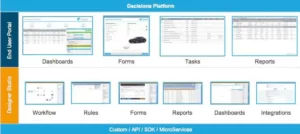How the Software You Use Positions Your Business in the Market

I get to talk to a wide range of roles during the day here at Decisions. In the morning I could be talking to an IT executive at a financial services organization in the UK. In the afternoon it could be a project manager at a major hollywood studio here in the US. In between it could be a group call with line of business team members and shared IT resources. The value that Decisions provides truly is different for each one of these people that I get to talk to during my day. And while each understands why they want Decisions – each may not understand the real reason why their colleagues may want Decisions.
If you’ve been to one of our introductory webinars (decisions.com/events) or booked a demo with us (decisions.com/schedule-demo/) then you’ve seen a diagram like this one:

This diagram is used to help folks who are new to Decisions understand the difference between the end user experience – somebody who is actually doing their job inside Decisions day to day – and the Designer Studio – the place where you can make changes to the software without writing any code.
Further than that – it’s important to understand “who can” and “who should” be making changes in the Designer Studio. For example – if you work in a bank as an analyst responsible for optimizing lending decisions – then when you log in to Decisions you would only see a few rules that you can change with dropdowns and checkboxes.
On the other hand – if you are an IT administrator who supports the loan processing platform inside the bank and all of its connections to other puzzle pieces in your enterprise stack – then you might have access to all of these designers to add new data types, map new data, change the rule hierarchy your analysts are using, or build a new workflow that connects to the new CRM solution that you are going live with next month.
And then there is the business executive – who wants to understand the process at a high level and its impact on key business measures. Instead of changing rules, or integrating the process with a new CRM – this person wants to see how the rules themselves are impacting the loan portfolio over time. This might be in a report – or even one of our new business models (fancy real time infographics derived from a Decisions Project of workflows and rules – coming in 5.0 this year).
So how does this all come together? I think it boils down a higher level business objective.
When you use software in your business you are making a significant decision. You are choosing to either:
- use software that you can change rapidly to position yourself in the market with
or
- you can use software that positions you and makes the world very expensive to change
Building discrete processes from scratch with custom code is like creating railroad tracks from gold and then laying them from point A to point B. As soon as you realize you want to get to point C instead of point B – you’ve got to leave the golden tracks you already laid behind and start smelting new parts and laying new tracks.
Purchasing an off the shelf software product is like buying an existing railroad – fully laid – that will get you from point A to point B, but again, when you realize that point C is important your going to need to find some additional railroad somewhere. That might be another product – or that might be more golden railroad (custom code) that you need to smelt and then lay.
Using a platform like Decisions is like having a supplier of railroad parts that are ready to be laid wherever you need to go. You can get to point C faster, and for the same amount of money over time as either of the other options build to point D and E as well.
Even if you can answer the question of where you want to be positioned… you probably realize that will need to change. So how you get there, and what software you use, is going to make the biggest difference in the long run.
Latest Articles
- Solving the Complexity Crisis in Excess & Surplus Insurance
- Fixing Lead Management with a Rules-Driven Approach: Why You Don’t Need Another Martech Tool
- Balancing Risk and Profitability: The Key to Smarter Insurance Pricing
- Blueprint Two Phase II: From Oversight to Bordereaux
- Rethinking Lead Flow Logic with Rules-Driven Automation: Why You Don’t Need Another Martech Tool
- Taming the Complexity of Workers’ Compensation Insurance—Before Inefficiencies Cost You More
- Improving Institutional Efficiency: How Process Mining Enhances University Operations
- Dynamic Pricing in Specialty Insurance: Adapting Rates in Real-Time
- The Faster, Smarter, No-Cost Chatbot Solution
- Extending SAP Capabilities with Low-Code Automation
- Why Your Automation Strategy Is Incomplete Without Process Mining
- 7 Fraud Prevention Tactics You Can Automate with a Rules Engine
- How Smart Lenders Use Low-Code Automation to Stay Fast, Compliant, and Competitive
- How Universities Can Protect Millions in Revenue with Faster Appeals
- Future-Proof Your Business: The 5 Tech Advancements You Can’t Afford to Ignore

